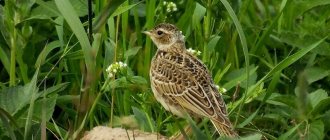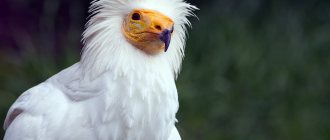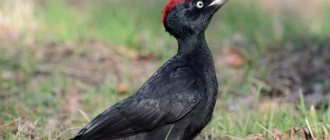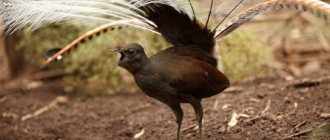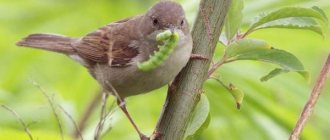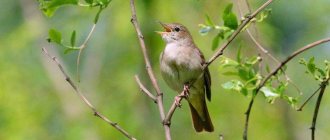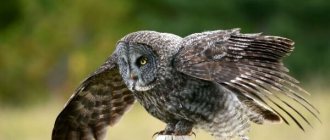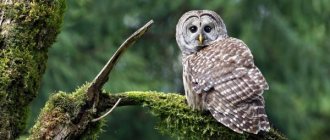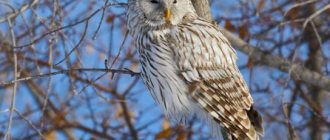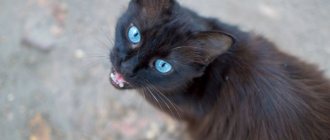Appearance
The body size is from 60 to 85 centimeters in length, and the wingspan is 1.5 meters. The weight of these representatives can reach up to 1.2 kilograms. The facial disc is pronounced and gray in color with a large number of dark concentric circles. On the head are small yellow eyes with dark eyelids. White feathers near the eyes form a cross. The base of the beak is yellow with a gray tint, and the beak itself is yellow. There is a dark spot under the beak. The main color of the great gray owl is gray with small black stripes. The lower part of the body is pale gray with streaks. The plumage on the paws and toes is gray. The owl's long tail is colored with large transverse stripes, which end in a rather large dark stripe. Sexual dimorphism means that females are much more massive and larger than males.
Description of the bird
The big-headed owl is smoky-gray in color, the head turns up to 270°. No ear tufts are observed. The plumage is camouflage, reminiscent of the color of tree bark.
It is the largest species of all tawny owls, weighing up to 640g. It has the size of a small chicken, the body length is 63 - 69 cm. The wing is 41 - 48 cm, the span reaches 129 - 160 cm.
What does it look like
The color of an adult individual is gray, the back is decorated with individual light spots, passing onto the shoulders and both wings in the form of subtle light stripes. The wings on top are framed with white and dark streaks.
The yellow eyes are emphasized by dark circular stripes, reminiscent of the appearance of rings on a cut tree trunk. Above the eyes there are “eyebrows” in the form of two white stripes. The expression on the “face” is one of surprise and wariness.
Under the beak the color is dark with a light edge of the “beard”. The abdomen is light, it is colored with large dark longitudinal stripes.
The tail feathers are painted with light stripes, the tail feathers are darkened, turning towards the end into a wide dark stripe. It can be seen in both sitting and flying birds. The legs are gray, the tarsus and toes are feathered.
Females do not differ in color from males, only they look much larger. The owls shout to each other with their voices:
- he muffled a cry of “goo-goo”;
- she says a long “goooo”.
Video with the voices of Tawny Owls (how they scream and sing)
Habitat
The habitat of the Great Gray Owl has spread to Canada and Alaska. Most populations are located in northern Europe and the center of the European side of Russia. Some representatives are found in Siberia and Sakhalin.
The tawny owl chooses coniferous and spruce forests as its habitat and can inhabit taiga and mountain forests. The choice of habitat is determined by the availability of sufficient food.
Gray owl in the Red Book
This species is listed in the International Red Book. It is also included in the Red Book of many regions of Russia as an endangered subspecies.
Main causes of extinction
The main reasons are considered:
- destruction of old-growth forests, habitats suitable for life;
- poaching is the direct extermination of birds.
The cause of bird extinction is also human activity.
Current population situation
The number of individuals fluctuates, it depends on the number of mouse-like rodents, the main food of the great gray owl. Large breeding occurs in the year of peak number of voles. In the absence of food, birds migrate to areas where there is a sufficient amount of food.
In recent years, no noticeable changes in numbers have been observed, and no long-term trends have been identified. Do you need to take protective measures?
The gray owl is considered a protected species according to the CITES Convention. The countries where they live also protect this species at the legislative level. To preserve the population, it is necessary to promote its protection and to strictly observe the ban on its shooting.
Nutrition
The Great Gray Owl's main diet consists of mouse-like rodents, shrews and small mammals. Sometimes squirrels, small birds, hares, frogs and some large insects can be hunted as large prey. An owl can search for prey from a perch or during a slow flight not exceeding 5 meters above the ground. It feeds mainly in open areas. During the nesting period, gray owls prefer to hunt during daylight hours on forest edges and clearings. What makes this owl an excellent predator is its developed hearing and facial disc, which allows it to hear the subtle rustles of a potential prey. Having grabbed its prey with sharp claws, the great gray owl eats it whole.
great gray owl
- home
- Articles
- Encyclopedia of Animal Species
- Wild birds
- great gray owl
- Content
- Classification
- Appearance
- Distribution and habitat
- Behavior and lifestyle
- Nutrition
- Reproduction
- Sources
The great gray owl (lat. Strix nebulosa) is the largest representative of the genus of tawny owls living in Russia. In size it surpasses even its similar long-tailed relative. But unlike that one, the Great Gray Owl has dark circles on its facial crown and yellow eyes. Also, the great gray owl, like other owls, does not have ears. And it can be easily distinguished from an eagle owl by its gray plumage. The gray owl species has long been endangered and is therefore under the protection of nature conservationists. But in general, finding differences among representatives of the genus is quite difficult to the unprofessional eye. The most significant of these, which the bearded owl possesses, is reflected in its name. Under its beak, this tawny owl has black feathers that resemble a thin beard. And the habitat of the great gray owl is unique - these are dense taiga forests. True, it is rare to observe an owl, since it carefully hides its nests and generally leads a very inconspicuous lifestyle. And in terms of aggressiveness, the gray owl can give odds to any feathered predator, especially when it comes to protecting the nest. The owl has very dense and dense plumage, which often makes it appear larger than it actually is. And what especially stands out is the large head with a unique pattern - circular stripes. And under the facial crown on the neck, the gray owl wears a white stripe, similar to a bow tie. And she is also able to regulate the temperature of her own body, opening or, conversely, compressing her dense plumage.
Classification Kingdom: Animals Phylum: Chordata Subtype: Vertebrates Class: Birds Subclass: New palates Order: Owls Family: Owls Genus: Tawny owls Species: Great gray owl Strix nebulosa
Appearance The great gray owl is surprisingly, almost cartoonishly large-headed. And her body is slender and narrow, unlike the fluffy silhouettes of other owls. The great gray owl can be distinguished from the common gray owl by its lighter smoky-gray color with a complete absence of rufous and by its larger size. Its overall “height” is about 60 cm, its wingspan is almost one and a half meters, and its weight sometimes exceeds a kilogram. The amazing yellow eyes of an owl have a pattern on the iris in the form of dark concentric stripes. Their color is explained by their lifestyle. This bird cannot be called purely nocturnal; it is rather crepuscular, although sometimes active during daylight hours. The already mentioned black beard under the beak also stands out in the appearance of the tawny owl. And if you look at the owl from a close distance, you can see the stiff feathers inside the face mask, standing on end at the top. Female Great Gray Owls, like other owls, are larger than males. As for the plumage, it is quite colorful. On the back, the feathers are grayish-brown with longitudinal and transverse dark and light streaks, on the crown, back of the head and behind the neck there are dark strokes located in a circle, the wings are darker and striped below, and there are noticeable black spots at the eyes. The Great Gray Owl's belly is light, but also speckled with brown. A noticeable yellow beak seems to protrude from the white “eyebrows” that connect longitudinally between the eyes. The claws are powerful, brown in color, the legs are completely feathered down to them. Sometimes the feathers on the facial corolla may have a yellowish tint. The great gray owl also has a long tail, which is related to the long-tailed owl, which belongs to the same genus. And the voice of the Great Gray Owl is powerful, almost trumpet-like, with the predominant sounds “oooh”.
Distribution and habitat The Great Gray Owl is a taiga resident and inhabitant of mountain forests. It can be found all over from the Kola Peninsula to the mountainous areas of Primorye. The northern border of the habitat is marked by tall forests and continues south to the Baltic countries, Germany, and the center of European Russia. The taiga climate of Siberia, the forests of Transbaikalia, and the harsh conditions of Sakhalin are also to the liking of this owl. However, it can settle further south, for example, in Mongolia. And in winter it sometimes flies into the central zone. Another continent where you can find this owl is North America. There she lives from central Alaska, Mackenzie, Quebec south to British Columbia, Ontario, the Sierra Nevada mountain system, Idaho, as well as the warm southern states of Montana and California. If a great gray owl chooses taiga plantations, it must be with high humidity - swampy ones, as well as alternating with open areas - burnt areas and wastelands. This owl does not build nests, but occupies someone else’s; for example, in Lapland it can easily settle in the nest of a woolly buzzard or goshawk, that is, mainly large feathered predators.
Behavior and lifestyle The great gray owl is active not only at night, but it is extremely rare to see it even during the day. This bird is unusually secretive and practically never flies outside its forest. Like other taiga birds, it is sedentary, and only a lack of food can incline an owl to a nomadic life. At sunrise and sunset, you can watch the Great Gray Owl's slow, silent flight over the moss marshes and hear its deep voice. And if an owl begins roll call near the nest, then the sounds made are more reminiscent of the calls of a great owl. When nesting time arrives, the gray owl switches exclusively to daytime hunting. And if, in extremely rare cases, she does build her own nest, then, most likely, it will be located high from the ground, for example, at the very top of some broken trunk. This bird is very attached to its nesting and hunting area and moves only if something seriously displeases it. In normal times, the great gray owl hunts both during the day and at night. She sets up an ambush very cunningly; for example, in winter she may well bury herself in a snowdrift. The bird also hides in a tree or near open areas, for example, near roads, and sometimes navigates more by hearing than by looking for prey. Acute hearing sometimes allows the gray owl to recognize its prey, even if it is buried underground to a depth of 30 cm. And if a rodent is hiding under the snow, the owl easily determines its location and pulls out the animal with its powerful claws. But the great gray owl does not have one consistent hunting style. Sometimes she can fly very low above the ground, looking for prey. This owl is a real long-liver among birds. Its lifespan in captivity with proper care can be 40 years, but in nature it is, alas, much shorter. From a food chain perspective, the location of the great gray owl is very important because it stabilizes the rodent population. If the owl does not hunt, then it flies little, short distances and generally close to the ground, except when approaching the nest. The great gray owl is not known for its love of warm climates, which is why it lives mainly in the northern regions and does not tolerate heat well. On hot summer days, the owl hides in the shade of tree crowns and spreads its plumage, ventilating itself. In terms of population size, great gray owl populations are fairly stable and rarely fluctuate due to changes in food resources. The behavior of tawny owls in captivity is also of great interest. These owls quickly get used to artificial living conditions. Scientists who have observed the development of great gray owls since childhood say that at first the owlets brought to the nursery are especially wild, and when you try to touch them, they click their beaks threateningly or even fall on their backs, pressing their paws to their chests and spreading their clawed fingers. Adult owls also have a chance to get used to humans, although they will never become completely tame.
Diet The food of great gray owls is standard for most owls - small rodents. But sometimes the owl comes across squirrels or small birds, and sometimes a larger animal, for example, a chipmunk, sable, rabbit, weasel or hare, becomes its victim. Amphibians, snakes, and sometimes even fish do not escape the claws of a feathered predator. The remains around a great gray owl's nest can often be used to determine its seasonal diet. And of course, the more abundant the food, the greater the number of owls in a given territory. And if there are problems with food, then the gray owl may completely disappear from the forest. In some parts of the world, scientists have determined the food preferences of this owl. For example, in Scandinavia it especially often prefers lemmings, and in Eastern Siberia, hazel grouse. In summer, the tawny owl's diet is dominated by mice. Accurate calculations even made it possible to determine that during the winter the owl destroys approximately 32 hazel grouse, 12 hares, 10 squirrels, 4 wood grouse and 5 black grouse. Ornithologists were able to learn more about the feeding habits of tawny owls from observing these owls in the nursery. It turns out that they are able to feed at large intervals. And if there is a lot of food, then the owl in the full sense of the word can be characterized by the expression “fed up.” She will eat until her stomach is so full that she cannot close her beak. It is no coincidence that this bird has the same “insatiable” name. Over time, any tawny owl, including the great gray owl, can be taught to eat meat, mealworms and other atypical food, but it will never refuse a freshly caught mouse, even if it has previously been fed up with something else.
Reproduction Mating games among gray owls begin in the spring and are marked by loud, peculiar trills of males. When the female selects a suitable place for a nest, takes someone else’s, chooses a hollow or just a notch on a stump, she will lay 2-4 white oblong eggs up to 5 cm in size directly on the surface. And already in May, hatched chicks can be found in the forests of Russia. In years with abundant food, Great Gray Owls have larger clutches - up to 6 eggs. There is even a known case when in Lapland in the 19th century there was a real invasion of rodents, so there simply weren’t enough owls for them all, and people found a nest with 9 owlets in the forest. Sitting on the clutch, the mother gray owl takes a special pose, raising her tail and wings high, thereby resembling a domestic hen. Some researchers believe that the male owl also helps incubate the chicks, but this fact has not been proven for sure. But information about the behavior of mothers of great gray owls when protecting the nest is completely contradictory. Some researchers claim that females actively defend their offspring, while others claim that the owl is simply reluctant to leave the clutch and flies around, clicking its beak threateningly. Gray owl chicks, unlike other owls, develop slowly, being born fluffy, with gray backs and white bellies. If their long-tailed and common relatives begin to fly out within a month, then the bearded babies sit in the nest for almost a month and a half, and acquire suitable plumage no earlier than mid-August. And they are not born all together, but one at a time, so that the last chick can hatch when the eldest has already grown noticeably. The hierarchy in feeding is also corresponding. The strongest firstborn gets food first, then the second born, and so on in order of seniority. The young stay for a long time close to the adult owls, who feed them almost all summer.
Sources https://ru.wikipedia.org/ https://www.ecosystema.ru/ https://www.floranimal.ru https://www.rt-online.ru https://www.apus.ru / https://yachtmirabel.narod.ru/
Health to you and your pets!
© 2022 ZOOVET Team We are always happy to help you! 24-hour consultation: +7 Make an appointment [email protected]
Return to list
Reproduction
Most Great Gray Owls are monogamous. The breeding season is accompanied by the search for a mate and courtship. This period lasts from winter. Males begin to work harder to get food for the female, preen their feathers, and actively search for nests. Many males choose old hawk settlements as a nest. The female lays up to 5 eggs in the selected nest and incubates them for 28 days. During this period, the male obtains food for two. The chicks become mature at 4 weeks, and ready to fly at 8 weeks of age.
Gray owl with chick
Description and features of the tawny owl
A representative of the owl family is the nocturnal owl . It has soft fluffy plumage, visually transforming its appearance into a very impressive and powerful one, increasing its size, although the creatures weigh on average no more than a kilogram and are inferior in size to their relatives, the eagle owl, having a length of about half a meter.
The external appearance of the birds is quite typical for owls. However, they do not have feather “ears”. The beak of birds is high, laterally flattened; the loose plumage has a reddish or grayish tint, strewn with small brown markings.
Moving in the dark, the tawny owl uses a perfect natural acoustic locator, inherited from its prudent nature. These are specially designed auricles, hidden under the feathers of the facial part and covered with skin folds.
It is interesting that the left region of the hearing organs of the tawny owl is always smaller in size than the right. Such asymmetry is typical for all owls, but in owls it is so pronounced that it even causes deformation of the skull. The iris of the night creature's eyes is brown.
Bird calls - Great Gray Owl (Strix nebulosa). Video (00:00:52)
Great Gray Owl (lat. Strix nebulosa) Large-headed owl, color smoky gray without red tones. The eyes are yellow with dark concentric stripes around them. A black spot under the beak, similar to a beard, is how this species got its name. The underside of the wing is striped. It lives in the taiga zone, sometimes in mountain forests. Distributed from the Kola Peninsula to the Primorye mountains. From the borders of the tall forest in the north to East Prussia, the Baltic states, and the central strip of the European part of Russia (about 52° north latitude). It is also found in Siberia to Transbaikalia, the Amur region, Sakhalin and Mongolia. In winter, it occasionally appears in the central zone.
Spreading
It lives in the forest zone of Eurasia and North America. Likes to live in the old taiga with swamps, glades, burnt areas or clearings. It has a sedentary lifestyle, hunting near the nest all year round, but in case of low rodent numbers it can migrate.
Rarely does it catch a person's eye. This is a rare species that needs protection. Listed in the Red Books of the Ural regions.
Interesting fact: the great gray owl is the symbol of the Canadian province of Manitoba.
Gray owls are long-lived birds. There are cases when in captivity they lived up to 40 years.
The largest owl of the genus Tawny Owls. It is not currently on display at the zoo.
Origin of the species and description
Photo: Tawny Owl
There are several main versions of the origin of birds. According to one of them, Archeopteryx is considered the oldest species, and they appeared in the Jurassic period and were related to the maniraptor dinosaurs. According to another hypothesis, they arose earlier, back in the Triassic period, and descended from archosaurs, and the first bird was Protoavis.
But before the appearance of owls, in particular owls, it was still far away - it is assumed that their ancestors were arboreal climbing birds related to Coraciiformes, and the first owls appeared at the end of the Paleocene.
Video: Tawny Owl
The oldest owl known to science is the fossil Ogygoptynx wetmorei. The genus to which she belonged became completely extinct, like the other owls that appeared first. The oldest owls found by paleoantologists date back to the Lower Pleistocene - so they lived about 600,000 years ago, which is very short by evolutionary standards.
It is assumed that the oldest owls were active during the day and fed mainly on insects, perhaps specializing in carrion. Over time, they switched to a nocturnal lifestyle - this was largely due to the fact that the largest insects are active at night, and owls adapted to their rhythm of life.
Moreover, at night they had much less competitors. Over time, their priorities changed, and they began to feed primarily on rodents, although many modern owls, including owls, sometimes eat insects. They also developed their own hunting style, based not on flight speed, like daytime birds, but on secretly stalking prey and a sudden attack.
The scientific description of owls was made by Carl Linnaeus in 1758, he also gave the genus the name Strix, and also described many individual species. This process continued throughout the 18th-20th centuries, and the desert owl was identified only in 2015; it was previously considered a subspecies of the pallid owl.
Social structure and reproduction
Photo: Tawny owl chicks
Tawny owls often live in pairs; they can also settle in larger groups, but at a relative distance from each other, because otherwise there will not be enough prey for everyone. However, this depends on the type of bird: there are more aggressive owls that do not tolerate the proximity of other owls, there are less so - sometimes they even live in the same tree with birds of prey of other species.
Small birds, for example, passerines, react to a flying owl with alarming cries, warning their relatives of danger. It usually does not compete with large predators, since they hunt during the day, but conflicts are still possible.
Some species are very territorial and tend to defend their “domains”. If someone is in them, the bird screams and in every possible way demonstrates its readiness to attack, but does not attack immediately and gives time to leave. If the “intruder” does not take advantage of this opportunity, he proceeds to active actions - cats, dogs, foxes, and people too have been attacked by owls more than once.
Pairs are formed for more than one year - tawny owls can spend their entire lives together. An approximately equal ratio of males and females at sexual maturity promotes monogamy. But in some species, bigamy is also common - sometimes two females share one male, and they can have either one nest or two not far from each other.
During reproduction there are pronounced species characteristics. Thus, the great gray owl, unlike other species, does not build nests at all; instead, it settles in the abandoned nests of other birds of suitable size. They usually make nests in hollows, sometimes in the attics of abandoned houses.
The beginning of the mating season is determined by the climate in which the tawny owl lives. In cold climates, it can occur as soon as winter ends, and by the middle or end of spring the chicks are already beginning an independent life. In the tropics it may be late summer or early autumn. Among the rituals, sound signals can be distinguished - at the onset of the mating season, the forest is filled with the drawn-out hoots of males and short responses of females.
They usually lay 2 to 4 eggs, after which they diligently incubate them until the chicks hatch - this usually takes 4 weeks. Sometimes males also participate in incubation, but not in all species. They also protect the nest from attacks by predators and bring food to the females, who cannot tear themselves away from incubating eggs for hunting.
Newborn chicks have white down, then gradually they are covered with dark stripes. By one and a half months they can already fly a little, and are fully feathered by 3-4. Almost immediately after this, they leave the nest and begin to live independently, although in some species young tawny owls can remain with their parents for up to 6-7 months.
LIFESTYLE
The Great Gray Owl lives as far north as pine, spruce and larch forests of Sweden, Finland and Poland to Eastern Siberia. Birds are also found in Alaska, Canada and the northern United States.
The migrations of great gray owls depend not on the time of year, but on the amount of prey, mainly voles and lemmings, whose populations are subject to significant seasonal fluctuations. If food is scarce, the entire population of gray owls migrates south, for example, northern European birds fly to southern Sweden to find rich food sources. Some pairs remain sedentary, but when food is scarce, they do not nest. The Great Gray Owl is active both day and night.
However, even during the day it is difficult to notice it, since its wings, painted gray, and a pattern of small spots that resemble the surface of tree bark, perfectly camouflage the bird on the tree. The great gray owl is most active at dusk, when the long shadows make it almost invisible. She flies out of the shelter silently as soon as she spots prey.
Tawny owl feeding
It is widely believed that the word “tawny owl” is translated from Old Russian as “an insatiable creature.” But although the bird is a typical night robber, it is not large enough to be interested in large prey.
When night comes to the deep forest thicket, the birds, sensitively listening to any rustle, glide between the trees, looking for mice, voles and shrews. They often insidiously attack frivolous victims, having first ambushed them.
And then, with one lightning-fast jerk, they overtake their prey in the place that their impressive hearing told them. Typically, the throw of an attacking tawny owl does not exceed six meters in length, although there are often enough marks.
Settling not far from agricultural lands, such birds bring considerable benefit to people by destroying rodents in the fields. The tawny owl, going out to hunt, tracking down places where small nocturnal birds gather, often visits them again to profit.
Often winged hunters greatly annoy hunters, leaving them without the skins of sables and other small fur-bearing animals that have fallen into traps and, as a result, become the prey of feathered robbers. The tawny owl's diet also includes various small invertebrates, amphibians and reptiles.
Taxonomy
Russian name
— Great Gray Owl
Latin name
— Strix nebulosa
English name
— Lapland (great gray) owl
Squad
— Owls
Family
— Real owls
The species name "nebulosa" comes from the Latin "Nebulosus", meaning nebula or misty. Among the names of this owl there are very interesting and unusual ones, for example, large gray ghost, phantom of the North, ashen owl, sooty owl.
INTERESTING FACTS, INFORMATION…
- A great gray owl hides, standing motionless on a tree branch not far from the trunk. So its feathers merge with the bark of the tree, and the bird looks like a protruding twig.
- Great gray owl chicks often act like little cannibals. The oldest and strongest of them, when there is not enough food, can eat their younger and weaker brothers and sisters.
- The great gray owl is the largest of the owls, but its size is due primarily to its plumage. In fact, the great gray owl weighs almost half as much as other owls of the same size.
What does a tawny owl eat?
Photo: Tawny Owl
The basis of the tawny owl’s “menu” is:
- rodents - mice, squirrels, etc.;
- lizards;
- frogs;
- small and medium-sized birds, such as black grouse or hazel grouse;
- insects;
- arthropods;
- fish.
Depending on the species and habitat, there are nuances - for example, tropical owls can feed on large spiders. Most species hunt at night, although there are also daytime hunters - for example, the great gray owl.
As a rule, these predators fly out after prey in the dark, listen carefully and catch every sound, even quiet and distant rustles do not escape them. Tawny owls roughly determine the size of prey by sound and, if it is suitable, that is, small enough, they go into ambush so as not to frighten off the potential victim with the noise of their wings.
They then wait for the moment when she is most defenseless and reach her in one quick burst, using almost exclusively their hearing to determine her exact location. Such a throw at prey is usually very fast, so that the prey does not even have time to come to its senses before it finds itself in the claws of a tawny owl - it covers 5-8 meters in just a few moments.
These birds are very effective at exterminating rodents, and therefore, if a tawny owl settles near cultivated lands, this can only benefit them. They prefer to eat rodents, and look for other prey only if they cannot be caught; they can destroy 150-200 mice in a month.
But for those in the north who hunt for skins, they do a lot of harm - they not only destroy valuable fur-bearing animals, but also often eat those already caught in a trap, spoiling the skins - after all, there is no need to catch them.
